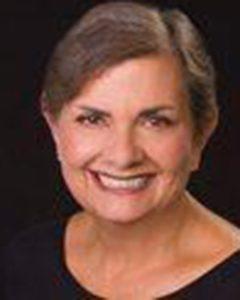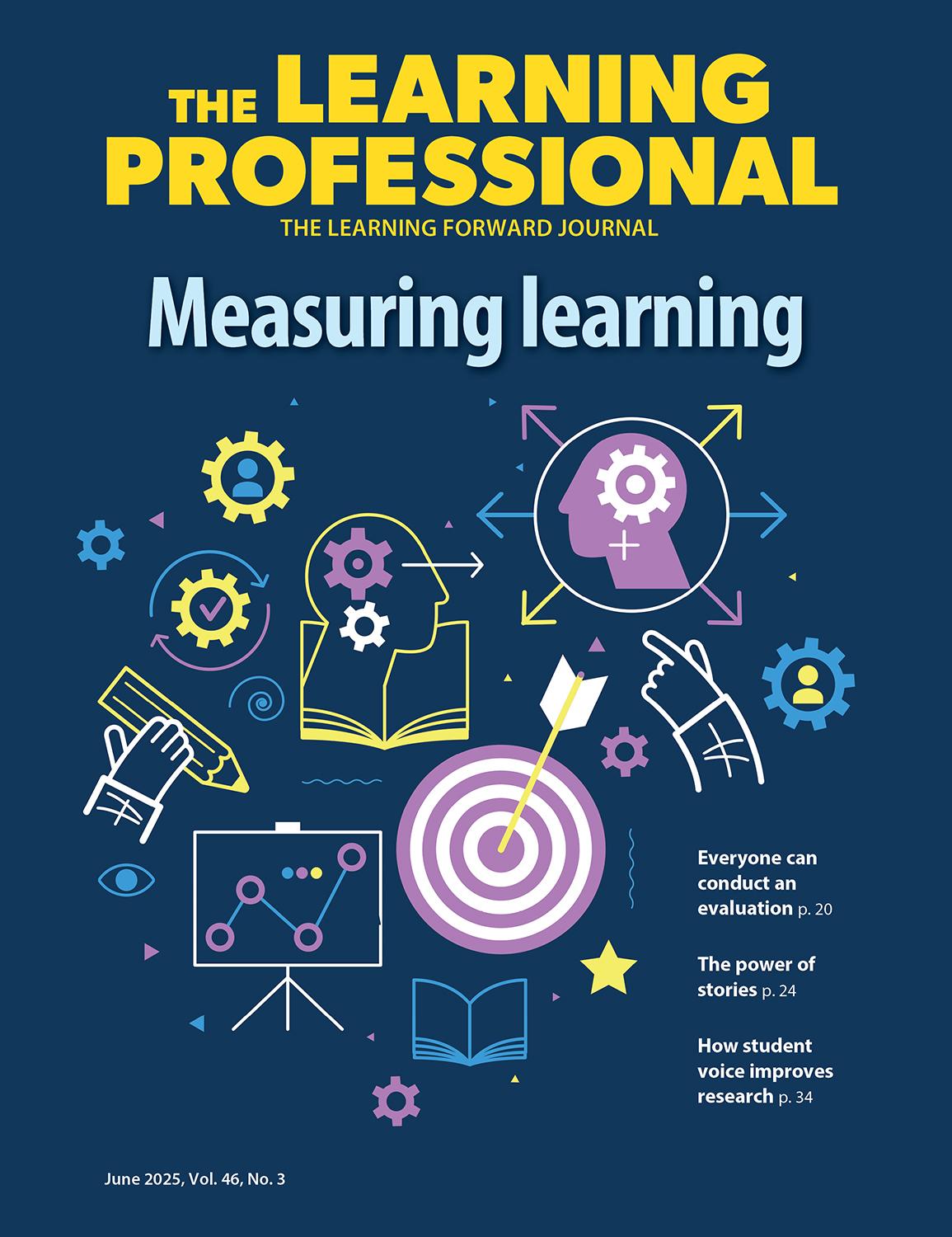Establish Time For Learning
Finding time to collaborate takes creativity and commitment.
By Joellen Killion
June 2016
Vol. 37 No. 3
Read the remaining content with membership access. Join or log in below to continue.
Sed ut perspiciatis unde omnis iste natus error sit voluptatem accusantium doloremque laudantium, totam rem aperiam, eaque ipsa quae ab illo inventore veritatis et quasi architecto beatae vitae dicta sunt explicabo. Nemo enim ipsam voluptatem quia voluptas sit aspernatur aut odit aut fugit, sed quia consequuntur magni dolores eos qui ratione voluptatem sequi nesciunt. Neque porro quisquam est, qui dolorem ipsum quia dolor sit amet, consectetur, adipisci velit, sed quia non numquam eius modi tempora incidunt ut labore et dolore magnam aliquam quaerat voluptatem.
Learn More About Finding Time
This article is adapted from the workbook Establishing Time for Professional Learning by Joellen Killion (Learning Forward, 2013). Finding time for job-embedded professional learning is one of the most frequently cited challenges with implementing the Common Core State Standards. The processes and tools in this workbook provide educators, parents, and community leaders with resources to increase or refine the use of time for educator collaboration to achieve goals associated with any key initiative. Where members can find the workbook: www.learningforward.org/docs/default-source/commoncore/establishing-time-for-professional-learning.pdf Where members can take the online course: www.learningforward.org/learning-opportunities/online-courses/establishing-time-for-collaborative-professional-learning
A Sample Case Study
This fictional case illustrates how districts can use and adapt existing time within the schedule for collaborative professional learning.
Teachers in Martin School District had attended a number of the state-sponsored summer institutes on Common Core State Standards as well as served on the state’s model curriculum writing team. Now they were turning their attention to moving the standards into routine practice in their classrooms.
Because the standards required teachers to make several significant shifts in their familiar content and instructional strategies, they had struggled to keep up with the necessary planning. They wondered if their decisions about classroom curriculum, formative assessments, and instruction aligned with those of their peers. They expressed this concern frequently at monthly faculty and grade-level, team, and department meetings.
The district’s Common Core State Standards implementation team met each month to consider challenges and issues related to implementation of Common Core standards. Members repeatedly talked about the need for teachers to have more time for professional learning, collaborative planning, reflection, analysis of student work, and refinement of content and pedagogy. The district’s chief academic officer and superintendent met with principals to understand how much time was currently available and what options were possible for increasing time for teacher collaboration without either reducing time for student instruction or causing a financial burden for the district.
To examine the questions, the district created a time study team and invited representatives of key stakeholder groups, including teachers, school administrators, parents, community members, central office staff, and students. The superintendent charged the team with studying the issue of time within established parameters. Within six months, the team offered its recommendation to the superintendent, who carried it to the school board. Upon the school board’s approval, the district applied for and received a waiver of 15 minutes from the state’s required amount of daily instructional time.
In the new school year, the district added the waiver time to the existing time, giving teachers in Martin School District 120 minutes each week over three days for collaborative professional learning and planning to make the curricular and instructional shifts designated by the new standards.
Principals, with support from central office staff and their own staff, acknowledged that they were responsible for creating the daily schedule within their schools to allocate the 120 minutes for collaboration, and for monitoring and supporting effective use of that new time. With the new school-day schedule, teachers accepted collective responsibility to use the time effectively to ensure each student’s needs were met so that achievement increases.
This additional time within the school day for teacher collaborative learning was insufficient to promote the deeper learning the district’s curriculum and instruction team knew teachers needed for full implementation of the new standards and assessments. They requested that the district consider increasing the number of professional learning days in the school-year calendar from four to eight to allow for content-specific, cross-school, and even districtwide professional learning focused on the district’s new curriculum and instructional framework.
Their desire was to establish a firm foundation of knowledge and skills in the instructional strategies for Common Core standards. District leaders also wanted to prepare teacher leaders, including all grade-level, team, and department chairs, on facilitating collaborative professional learning and work.
The first year of implementation of the revised school-day schedule was a learning experience for everyone. Teachers valued time with colleagues for learning and planning and acknowledged that they needed strategies and processes to be more efficient and effective. Principals asked for more guidance on how to support and coach teams and teacher leaders who facilitated the teams. Central office staff struggled with letting teachers determine the focus of a large portion of their professional learning.
At the end of year one, teachers and principals reported that, despite the challenges of learning to work collaboratively, the time was well-used. Teachers felt more confident in implementing the district’s new curriculum aligned with Common Core standards, had a greater respect for their peers’ contribution to their success, and valued the time to learn and work with colleagues. They reported that they had a stronger sense of community within the school. Most importantly, student achievement was steadily increasing, and principals reported that teachers were supporting each other’s professional growth.
Overall, teachers, principals, and district leaders know that educator learning is as crucial as student learning. They feel confident they are addressing the challenge of creating some of the time they request for educator learning. However, they know that they need to demonstrate that the investment in educator professional learning is paying dividends for students before they are able to achieve the goal of three to four hours per week and 10 days per year.
7 Steps To Establish Time For Professional Learning
- Form a time study team. Engage representatives from various parts of the school or school system community to participate in the time study process and determine who will develop recommendations for the decision makers.
- Examine assumptions about time. Explore processes for assessing current perceptions held about time for education. Understanding personal assumptions about time early in the process will provide fundamental information for the time study team as it engages in its work.
- Understand existing time. Develop strategies for conducting an analysis of how time is currently used to inform the work of the time study team. In some cases, repurposing existing time is the first way to increase time for collaborative professional learning.
- Study time options. Discover resources that can guide the time study team as members examine models from other schools and school systems to inform their work.
- Form and adopt recommendations about time. Launch a public discussion about how to fulfill the need within the given parameters. After developing concrete recommendations, members of the time study team should decide how to vet them for consideration and modification before they make final recommendations.
- Establish a plan to implement and evaluate accepted recommendations. Ongoing monitoring and assessment is an essential part of the work that can generate information about the efficiency and effectiveness of the time investment.
- Review time use and results. Use ongoing data to make adjustments and improvements in the use of time to achieve the maximum benefits for educators and students.
“The first thing to understand is that schedules are not sacred. Unfortunately, most school administrators believe they are sacred to the point of being married to them. As a former principal, I understand that factors such as our stomachs and yellow buses sometimes dictate the schedule.
All too often, however, schedules are geared to what is best for the bus drivers and cafeteria workers’ schedules — especially if they do both — rather than being geared to what is best for students and teachers.
“My point is that a schedule is not what enables or disables collaborative professional learning. It is the top-down commitment to professional learning, or lack thereof, that promotes or hinders collaborative professional learning. A schedule is a ‘thing’ that can be — and should be — manipulated in ways that are best for student learning. Collaborative professional learning does not begin with plans for a schedule change, but with commitment to a cultural change.”
— Jack Linton Assistant superintendent Petal (Mississippi) School District
References
ASCD. (2012). Fulfilling the promise of Common Core State Standards: Moving from adoption to implementation. Alexandria, VA: Author.
Colvin, G. (2010). Talent is overrated: What really separates world-class performers from everybody else. New York, NY: Portfolio.
Ericsson, A., Prietula, M., & Cokely, E. (2007, July- August). The making of an expert. Harvard Business Review, 1-8.
Gladwell, M. (2008). Outliers: The story of success. New York, NY: Little, Brown & Company.
Kaplan, C. & Chan, R. (2011). Time well spent: Eight powerful practices of successful expanded-time schools. Boston, MA: National Center on Time & Learning.
Killion, J. (2013). Establishing time for professional learning. Oxford, OH: Learning Forward.
MetLife. (2012). The MetLife survey of the American teacher: Teachers, parents, and the economy. New York, NY: Author.
MetLife. (2013). The MetLife survey of the American teacher: Challenges in school leadership. New York, NY: Author.
Schillinger, D. (2010). An introduction to effectiveness, dissemination and implementation research: A resource manual for community-engaged research. San Francisco, CA: UCSF Clinical & Translational Science Institute.
Scholastic & Bill and Melinda Gates Foundation. (2012). Primary sources: 2012: America’s teachers on the teaching profession. New York, NY: Scholastic Press.
Wei, R.C., Darling-Hammond, L., Andree, A., Richardson, N., & Orphanos, S. (2009). Professional learning in the learning profession: A status report on teacher development in the United States and abroad. Technical report. Dallas, TX: National Staff Development Council.

Joellen Killion is a senior advisor to Learning Forward and a sought-after speaker and facilitator who is an expert in linking professional learning and student learning. She has extensive experience in planning, design, implementation, and evaluation of high-quality, standards-based professional learning at the school, system, and state/provincial levels. She is the author of many books including Assessing Impact, Coaching Matters, Taking the Lead, and The Feedback Process. Her latest evaluation articles for The Learning Professional are “7 reasons to evaluate professional learning” and “Is your professional learning working? 8 steps to find out.”
Recent Issues
NAVIGATING NEW ROLES
April 2025
Whether you’re new to your role or supporting others who are new,...
LEARNING DESIGNS
February 2025
How we learn influences what we learn. This issue shares essential...
BUILDING BRIDGES
December 2024
Students benefit when educators bridge the continuum of professional...
CURRICULUM-BASED PROFESSIONAL LEARNING
October 2024
High-quality curriculum requires skilled educators to put it into...








